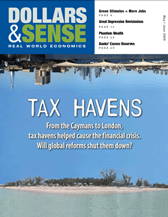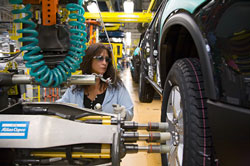Changing the Auto Industry from the Wheels Up
The problems of the U.S. auto industry call for radical solutions.
This is a web-only article from the website of Dollars & Sense: The Magazine of Economic Justice available at http://www.dollarsandsense.org

This is a web-only article, available only at www.dollarsandsense.org.
Subscribe Now
at a 30% discount.
Intro | Pt. I | Pt. II | Pt. III | Pt. IV | Pt. V | Pt. VI | Full article

Photo by Jim West
Part II: The Economics of Nationalization
The government could have nationalized GM or Chrysler for much less than what it handed over in bailout money.
The nationalization of large private companies has suddenly become part of mainstream U.S. political debate. Even mainstream commentators have advocated the (temporary) nationalization of major U.S. banks as a necessary fix of the financial sector. With nationalization no longer “beyond the pale” of respectable debate, talk of nationalizing the auto companies began to trickle into mainstream debate. Some commentators compared the auto companies to the bankrupt railroads of the 1970s, which were nationalized (as Conrail) and later re-privatized. [Note 31]
The current administration has not set out to nationalize either GM or Chrysler. “Nationalization,” at least in the sense of government majority ownership, however, became a real possibility with GM’s April restructuring plan. Under the plan, the government would receive a majority of the stock in the company in exchange for the cancellation of over $7 billion in the company’s debt (from the bailout loans). [Note 32] Administration officials hastened to explain that they had not aimed to nationalize the company, that the administration had “no desire to run an auto company,” and that it would not seek representation on the company’s board. [Note 33]
From a purely economic standpoint, the government could have easily nationalized GM for much less that it gave out in bailout loans. GM stock has been trading for under $4 per share for almost all of 2009. At this price, the company’s total “market capitalization”—the amount of money it would take to buy all the shares owned by members of the public—is around $2.5 billion. (This number is usually interpreted as investors’ collective valuation of what a company is worth.) At the late April price of less than $2 per share, it was about $1 billion. So the government could have bought all the shares in GM for between $1 billion and $2.5 billion, depending on the timing, or a majority stake for half that. [Note 34] (These calculations are harder to make for Chrysler, since it is not a publicly traded company and so its stock does not have a market price, but the story would probably be quite similar.)
Had the government bought a controlling stake in either company, however, the money paid for the shares would not have been available for current production, retooling, or research and development. (This money would have gone to the shareholders, not the company.) Instead, the government could have forced the companies, which had no other place to turn for credit since no private lenders were willing to loan them money, to issue it enough new stock to give the government a majority stake. The issuance of new stock reduces the portion of a company owned by existing stockholders. If GM issued the government enough stock to give it a majority stake (just over 50%), for example, this would have reduced existing stockholders’ stake by half. A one-half stake in GM would have cost about half of the company’s market capitalization, or about one-half billion dollars at the late April share price. That money would have been in the possession of a company the government now controlled, and therefore available for operations. The government could have made additional financing available to the now-government-controlled company for additional shares of new stock, or as loans.
Instead of pursuing these options, the government extended bailout loans to both companies. It has handed $15.4 billion to GM so far. [Note 35] GM’s bankruptcy plan assumes the government will extend another $11.6 billion in loans, for a total of $27 billion. The plan has the government cancelling $7.4 billion of GM’s debt, and receiving a little more than half the company. [Note 36] In effect, if the plan goes through, the government will have paid over $7 billion for half of a company that is, right now, worth about $1 billion. The government, in effect, has become one of the creditors making dramatic concessions (taking a “haircut”) in the companies’ restructuring plans.
Intro | Pt. I | Pt. II | Pt. III | Pt. IV | Pt. V | Pt. VI | Full article
End Notes:
31. Louis Uchitelle, Railroad Bailout May Offer a Model for Detroit, New York Times, March 15, 2009.
32. John D. Stoll and Sharon Terlep, Plan Sees a Smaller, Focuses—and Profitable—GM, Wall Street Journal, April 28, 2009.
33. Steven Mufson, GM’s New Road Map: Partial Nationalization, Washington Post, April 28, 2009.
34. General Motors Corporation, Analysis Tools, Historical Chart, New York Times; General Motors Coporation, Analysis Tools, Finanicals Tables, Fundamentals, New York Times.
35. Nick Bunkley, G.M. Posts a Quarterly Loss of $6 Billion, New York Times, May 7, 2009.
36. John D. Stoll and Sharon Terlep, Plan Sees a Smaller, Focuses—and Profitable—GM, Wall Street Journal, April 28, 2009.
Did you find this article useful? Please consider supporting our work by donating or subscribing.
